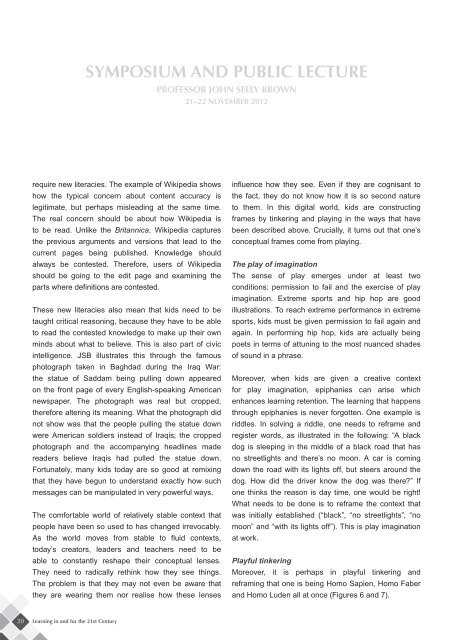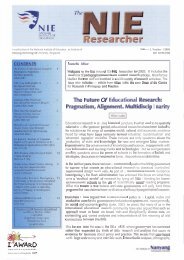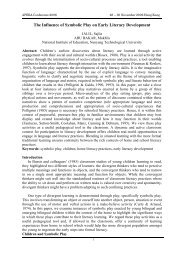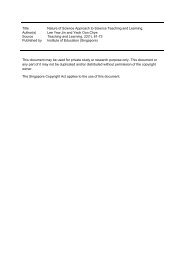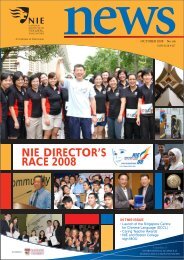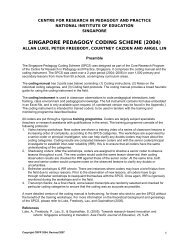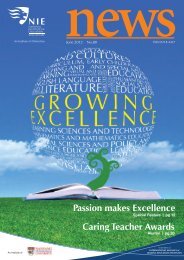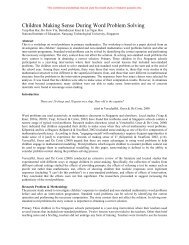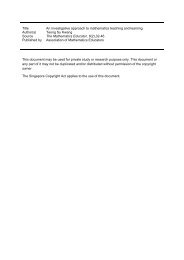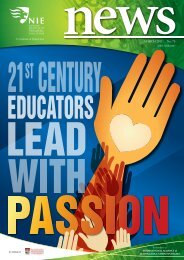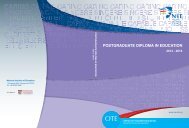Learning in and for the 21st Century - NIE Digital Repository
Learning in and for the 21st Century - NIE Digital Repository
Learning in and for the 21st Century - NIE Digital Repository
You also want an ePaper? Increase the reach of your titles
YUMPU automatically turns print PDFs into web optimized ePapers that Google loves.
SYMPOSIUM <strong>and</strong> PUBLIC LECTURE<br />
Professor JOHN SEELY BROWN<br />
21–22 November 2012<br />
require new literacies. The example of Wikipedia shows<br />
how <strong>the</strong> typical concern about content accuracy is<br />
legitimate, but perhaps mislead<strong>in</strong>g at <strong>the</strong> same time.<br />
The real concern should be about how Wikipedia is<br />
to be read. Unlike <strong>the</strong> Britannica, Wikipedia captures<br />
<strong>the</strong> previous arguments <strong>and</strong> versions that lead to <strong>the</strong><br />
current pages be<strong>in</strong>g published. Knowledge should<br />
always be contested. There<strong>for</strong>e, users of Wikipedia<br />
should be go<strong>in</strong>g to <strong>the</strong> edit page <strong>and</strong> exam<strong>in</strong><strong>in</strong>g <strong>the</strong><br />
parts where def<strong>in</strong>itions are contested.<br />
These new literacies also mean that kids need to be<br />
taught critical reason<strong>in</strong>g, because <strong>the</strong>y have to be able<br />
to read <strong>the</strong> contested knowledge to make up <strong>the</strong>ir own<br />
m<strong>in</strong>ds about what to believe. This is also part of civic<br />
<strong>in</strong>telligence. JSB illustrates this through <strong>the</strong> famous<br />
photograph taken <strong>in</strong> Baghdad dur<strong>in</strong>g <strong>the</strong> Iraq War:<br />
<strong>the</strong> statue of Saddam be<strong>in</strong>g pull<strong>in</strong>g down appeared<br />
on <strong>the</strong> front page of every English-speak<strong>in</strong>g American<br />
newspaper. The photograph was real but cropped,<br />
<strong>the</strong>re<strong>for</strong>e alter<strong>in</strong>g its mean<strong>in</strong>g. What <strong>the</strong> photograph did<br />
not show was that <strong>the</strong> people pull<strong>in</strong>g <strong>the</strong> statue down<br />
were American soldiers <strong>in</strong>stead of Iraqis; <strong>the</strong> cropped<br />
photograph <strong>and</strong> <strong>the</strong> accompany<strong>in</strong>g headl<strong>in</strong>es made<br />
readers believe Iraqis had pulled <strong>the</strong> statue down.<br />
Fortunately, many kids today are so good at remix<strong>in</strong>g<br />
that <strong>the</strong>y have begun to underst<strong>and</strong> exactly how such<br />
messages can be manipulated <strong>in</strong> very powerful ways.<br />
The com<strong>for</strong>table world of relatively stable context that<br />
people have been so used to has changed irrevocably.<br />
As <strong>the</strong> world moves from stable to fluid contexts,<br />
today’s creators, leaders <strong>and</strong> teachers need to be<br />
able to constantly reshape <strong>the</strong>ir conceptual lenses.<br />
They need to radically reth<strong>in</strong>k how <strong>the</strong>y see th<strong>in</strong>gs.<br />
The problem is that <strong>the</strong>y may not even be aware that<br />
<strong>the</strong>y are wear<strong>in</strong>g <strong>the</strong>m nor realise how <strong>the</strong>se lenses<br />
<strong>in</strong>fluence how <strong>the</strong>y see. Even if <strong>the</strong>y are cognisant to<br />
<strong>the</strong> fact, <strong>the</strong>y do not know how it is so second nature<br />
to <strong>the</strong>m. In this digital world, kids are construct<strong>in</strong>g<br />
frames by t<strong>in</strong>ker<strong>in</strong>g <strong>and</strong> play<strong>in</strong>g <strong>in</strong> <strong>the</strong> ways that have<br />
been described above. Crucially, it turns out that one’s<br />
conceptual frames come from play<strong>in</strong>g.<br />
The play of imag<strong>in</strong>ation<br />
The sense of play emerges under at least two<br />
conditions: permission to fail <strong>and</strong> <strong>the</strong> exercise of play<br />
imag<strong>in</strong>ation. Extreme sports <strong>and</strong> hip hop are good<br />
illustrations. To reach extreme per<strong>for</strong>mance <strong>in</strong> extreme<br />
sports, kids must be given permission to fail aga<strong>in</strong> <strong>and</strong><br />
aga<strong>in</strong>. In per<strong>for</strong>m<strong>in</strong>g hip hop, kids are actually be<strong>in</strong>g<br />
poets <strong>in</strong> terms of attun<strong>in</strong>g to <strong>the</strong> most nuanced shades<br />
of sound <strong>in</strong> a phrase.<br />
Moreover, when kids are given a creative context<br />
<strong>for</strong> play imag<strong>in</strong>ation, epiphanies can arise which<br />
enhances learn<strong>in</strong>g retention. The learn<strong>in</strong>g that happens<br />
through epiphanies is never <strong>for</strong>gotten. One example is<br />
riddles. In solv<strong>in</strong>g a riddle, one needs to reframe <strong>and</strong><br />
register words, as illustrated <strong>in</strong> <strong>the</strong> follow<strong>in</strong>g: “A black<br />
dog is sleep<strong>in</strong>g <strong>in</strong> <strong>the</strong> middle of a black road that has<br />
no streetlights <strong>and</strong> <strong>the</strong>re’s no moon. A car is com<strong>in</strong>g<br />
down <strong>the</strong> road with its lights off, but steers around <strong>the</strong><br />
dog. How did <strong>the</strong> driver know <strong>the</strong> dog was <strong>the</strong>re” If<br />
one th<strong>in</strong>ks <strong>the</strong> reason is day time, one would be right!<br />
What needs to be done is to reframe <strong>the</strong> context that<br />
was <strong>in</strong>itially established (“black”, “no streetlights”, “no<br />
moon” <strong>and</strong> “with its lights off”). This is play imag<strong>in</strong>ation<br />
at work.<br />
Playful t<strong>in</strong>ker<strong>in</strong>g<br />
Moreover, it is perhaps <strong>in</strong> playful t<strong>in</strong>ker<strong>in</strong>g <strong>and</strong><br />
refram<strong>in</strong>g that one is be<strong>in</strong>g Homo Sapien, Homo Faber<br />
<strong>and</strong> Homo Luden all at once (Figures 6 <strong>and</strong> 7).<br />
20 <strong>Learn<strong>in</strong>g</strong> <strong>in</strong> <strong>and</strong> <strong>for</strong> <strong>the</strong> <strong>21st</strong> <strong>Century</strong>


